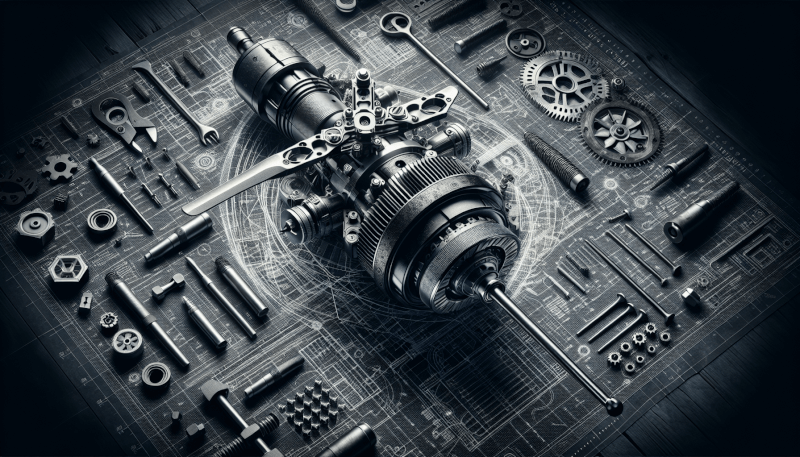Are you an avid RC helicopter enthusiast looking to take your flying skills to the next level? If so, then choosing the right motor for your RC heli is crucial. In our ultimate guide, we will walk you through the important factors to consider when selecting the perfect motor for your helicopter, ensuring that you can achieve optimal performance and an unforgettable flying experience. Whether you’re a beginner or an experienced pilot, this guide has got you covered with all the information you need to make an informed decision and soar to new heights in the world of RC helicopters.
Understanding RC Heli Motors
RC helicopters are an exciting hobby that brings joy and thrills to enthusiasts of all ages. One crucial component of these flying machines is the motor, which powers the helicopter’s rotor and enables it to take flight. Understanding the different types of RC heli motors and their specifications is vital when it comes to choosing the right motor for your heli.
Types of RC Heli Motors
There are two main types of RC heli motors: brushed and brushless motors. These motors differ in their construction, performance, and overall efficiency. Brushed motors have been around for a long time and are known for their simplicity and affordability. On the other hand, brushless motors are more advanced, offering higher power, torque, and longer lifespan.
Brushed vs. Brushless Motors
The primary difference between brushed and brushless motors lies in how they generate power. Brushed motors use brushes and a commutator to transfer electrical current to the rotor, resulting in a rotating motion. Brushless motors, on the other hand, eliminate the need for brushes by using an electronic controller, known as an ESC, to deliver power directly to the rotor. This design offers many advantages, including increased efficiency, reduced wear, and improved overall performance.
Understanding KV Rating
The KV (kilovolt) rating is one of the most crucial specifications to consider when choosing an RC heli motor. It indicates the rotational speed of the motor for each volt of input it receives. In simpler terms, a higher KV rating means the motor will spin faster, while a lower KV rating means the motor will rotate at a slower speed. Matching the appropriate KV rating to your heli’s requirements is essential for optimal performance and flight characteristics.
Important Considerations for Motor Size
Choosing the right motor size for your RC heli is essential for ensuring efficient power delivery and flight stability. The motor size refers to the physical dimensions of the motor, including its diameter and length. It is crucial to find a motor that fits properly within the helicopter’s frame, allowing for sufficient clearance and balance. Additionally, considering the weight of the motor and its impact on the heli’s overall weight distribution is crucial for maintaining stability and maneuverability during flight.
Determining Motor Power
Understanding the concept of motor power is key to selecting a motor that meets your heli’s propulsion needs. Motor power is typically measured in watts and determines the amount of thrust the motor generates. When matching motor power with your heli size, it is essential to consider factors such as rotor blade size, weight, and desired flight performance. By ensuring the motor’s power output matches your heli’s requirements, you can achieve optimal lift and responsiveness during flight.
Matching Motor Power with Heli Size
To determine the appropriate motor power for your RC heli, consider the size and weight of your aircraft. Smaller helis, such as micro or mini models, usually require lower power motors, while larger helis demand more powerful motors to provide sufficient thrust. Consulting the manufacturer’s recommendations and guidelines can be helpful in determining the suitable power range for your specific heli size.
Calculating Power-to-Weight Ratio
Another factor to consider when determining motor power is the power-to-weight ratio. This ratio measures the amount of power the motor produces relative to the weight of the RC heli. The higher the power-to-weight ratio, the better the helicopter’s performance, agility, and ability to perform aerobatic maneuvers. Balancing the power-to-weight ratio ensures optimal flight characteristics and responsiveness, allowing for enjoyable and dynamic flying experiences.
Considering Motor Efficiency
Motor efficiency plays a vital role in both the performance and overall lifespan of your RC helicopter. A more efficient motor can convert a higher percentage of electrical energy into mechanical energy, resulting in increased performance and less wasted power. Factors that contribute to motor efficiency include design, construction quality, and advanced technologies such as improved winding techniques and reduced internal resistance. Opting for a higher-efficiency motor can lead to longer flight times and greater overall satisfaction with your RC heli.

Choosing the Right KV Rating
Selecting the appropriate KV rating for your RC heli motor is crucial for achieving the desired flight characteristics and performance. The KV rating determines the motor’s rotational speed, and different helis require different KV ranges to function optimally.
Understanding KV Rating
The KV rating measures the rotational speed of the motor per volt applied to it. Higher KV-rated motors spin faster, while lower KV-rated motors rotate at slower speeds. It is essential to choose a KV rating that matches your heli’s desired flight style, weight, and rotor size for optimal overall performance.
Recommended KV Range for Different Helis
Different types of helis require specific KV ranges to perform at their best. For example, a micro-sized heli typically requires a lower KV-rated motor, while larger helis may require higher KV ratings to generate sufficient lift and power. It is crucial to consult the manufacturer’s guidelines or seek advice from experienced pilots to determine the recommended KV range for your specific heli model.
Matching KV Rating with Battery and Rotor Size
When selecting a motor with a specific KV rating, it is important to consider the compatibility with your battery and rotor size. The KV rating should be chosen in conjunction with the voltage supplied by the battery to ensure appropriate performance and efficiency. Additionally, considering the rotor size and weight is crucial to prevent overloading the motor, as larger rotors create more drag and require motors with higher KV ratings.
Considering Flying Style and Performance
Your flying style and desired performance also play a significant role in choosing the right KV rating for your RC heli motor. If you enjoy aggressive and aerobatic flying, a motor with a higher KV rating may be suitable for achieving the desired power and responsiveness. On the other hand, if you prefer a more relaxed and smooth flying style, a motor with a lower KV rating may provide better control and stability. Understanding your flying preferences will help guide you in selecting the ideal KV rating for your heli.
Considering Brushed vs. Brushless Motors
Choosing between brushed and brushless motors is an important decision when selecting a motor for your RC heli. Each type has its own advantages and disadvantages that should be considered based on your specific needs and preferences.
Differences between Brushed and Brushless Motors
The main difference between brushed and brushless motors lies in their internal construction and operation. Brushed motors use brushes and a commutator to transfer electrical current to the rotor, while brushless motors utilize an electronic controller (ESC) to deliver power directly to the rotor windings. The absence of brushes in brushless motors eliminates the need for maintenance, reduces wear, and improves overall efficiency.
Advantages and Disadvantages of Brushed Motors
Brushed motors have several advantages, including simplicity, lower cost, and ease of maintenance. They are well-suited for beginners or those on a budget who prioritize affordability over advanced features. However, brushed motors tend to have lower power, efficiency, and lifespan compared to brushless motors. Additionally, the presence of brushes leads to increased friction and wear, requiring occasional replacement.
Advantages and Disadvantages of Brushless Motors
Brushless motors offer numerous benefits that make them a popular choice among RC heli enthusiasts. They are known for their higher power, torque, and overall efficiency. They also have a longer lifespan due to the absence of brushes, resulting in reduced maintenance requirements. However, brushless motors tend to be more expensive than brushed motors, making them a better option for experienced pilots or those seeking enhanced performance.
Choosing the Ideal Motor Type
Choosing between brushed and brushless motors ultimately depends on your specific needs and preferences as an RC heli pilot. If you are new to the hobby and looking for a cost-effective option, a brushed motor may be a suitable choice. However, if you desire higher performance, increased efficiency, and longer lifespan, a brushless motor is the ideal option. Consider your budget, flying style, and long-term goals to determine which motor type suits your needs best.

Selecting the Right Motor Size
Selecting the appropriate motor size for your RC heli is crucial for ensuring optimal performance and flight characteristics. The motor size refers to its physical dimensions, including its diameter and length. Choosing a motor that fits properly within your heli’s frame is essential for clearance and balance.
Understanding Motor Sizes for RC Helis
Motor sizes are typically classified using standardized numbers, such as 180, 280, 360, etc. These numbers represent the motor’s diameter in millimeters. Different heli sizes require corresponding motor sizes to ensure compatibility and efficient power delivery.
Matching Motor Size with Helicopter Frame
To select the right motor size, take into consideration the size and type of your heli’s frame. Smaller helis, such as micro or mini models, generally require smaller motors, while larger helis demand larger motors to provide sufficient power. Consulting the manufacturer’s recommendations or seeking advice from experienced pilots can help you determine the ideal motor size for your specific heli model.
Considering Weight and Balance
In addition to the physical dimensions, the weight of the motor is a crucial factor to consider when selecting the right motor size. The motor’s weight affects the heli’s balance and stability during flight, and an imbalanced setup can lead to poor performance and handling. It is important to find a motor that matches your heli’s weight requirements and allows for proper weight distribution for optimal flight characteristics.
Finding the Optimal Motor Size
Finding the optimal motor size involves considering various factors, including frame compatibility, weight, and performance requirements. Balancing these aspects ensures that your RC heli operates efficiently, provides adequate power, and enables smooth, stable flight. Experimenting with different motor sizes or seeking advice from experienced pilots can help you fine-tune your setup and find the ideal motor size for your specific heli model.
Considerations for Motor Timing
Motor timing is an often-overlooked aspect when it comes to maximizing the performance and efficiency of your RC heli motor. Understanding the concept of motor timing and its effects is essential for achieving optimal power delivery and responsiveness.
Understanding Motor Timing
Motor timing refers to the timing of the electrical current that energizes the motor’s windings. By adjusting the timing, you can optimize the motor’s performance for different RPM ranges and flight conditions. Proper motor timing ensures efficient power delivery, reduced heat generation, and improved overall performance.
Effects of Motor Timing on Performance
Adjusting the motor timing can have significant effects on your heli’s performance. A higher timing setting results in increased RPM and power output, ideal for high-speed flights and aggressive maneuvers. Conversely, a lower timing setting reduces RPM and power, providing better efficiency and longer flight times. Finding the right motor timing setting requires experimentation and fine-tuning to achieve the desired balance between power, efficiency, and flight characteristics.
Finding the Ideal Motor Timing Setting
Determining the ideal motor timing setting for your RC heli often involves trial and error. Start by reviewing the manufacturer’s recommendations or seeking guidance from experienced pilots. Gradually adjust the timing setting and take note of the changes in motor performance, temperature, and flight characteristics. Aim to find a setting that delivers the desired power and responsiveness without excessive heat generation or reduced efficiency.
Customization and Fine-Tuning
Motor timing settings can vary depending on factors such as heli size, motor type, and flight style. As you gain experience and become more familiar with your particular setup, you may find that customizing the motor timing offers further improvements in performance. Experimenting with different settings and fine-tuning allows you to discover the optimal balance between power and efficiency for your specific RC heli.

Accounting for Voltage and Current
To ensure proper operation and performance, it is important to account for voltage and current requirements when selecting an RC heli motor. Matching the motor’s voltage rating with the battery and considering the ESC’s current limit are crucial steps in preventing motor overload and maximizing efficiency.
Understanding Voltage and Current
Voltage and current are fundamental electrical properties that play a vital role in powering and controlling an RC heli motor. Voltage, measured in volts (V), represents the electrical potential difference across the motor, while current, measured in amperes (A), represents the flow of electrical charge. Selecting a motor with the correct voltage rating and ensuring the ESC can handle the required current are crucial for optimal performance and preventing damage to the motor and electronic components.
Matching Motor Voltage with Battery
When choosing an RC heli motor, it is important to select one that is compatible with the voltage supplied by your battery. Voltage requirements vary depending on the motor’s design and performance characteristics. Using a motor with the correct voltage rating ensures proper power delivery and prevents potential damage to the motor and associated electronics.
Considering the ESC’s Current Limit
In addition to voltage, it is essential to consider the electronic speed controller’s (ESC) current limit when selecting an RC heli motor. The ESC acts as a bridge between the battery and motor, regulating the flow of current to ensure safe and efficient operation. Choosing a motor with a current rating that falls within the ESC’s limits prevents excessive current draw, motor overheating, and potential damage to the ESC and other electrical components.
Avoiding Overloading the Motor
Overloading the motor by exceeding its voltage or current limits can lead to reduced performance, decreased efficiency, and even permanent damage. It is crucial to strike a balance between power requirements and the motor’s capabilities to ensure safe and optimal operation. Checking the manufacturer’s specifications, consulting experienced pilots, or seeking advice from knowledgeable hobby shops can help guide you in selecting a motor that matches your RC heli’s voltage and current requirements.
Evaluating ESC Compatibility
Selecting an electronic speed controller (ESC) that is compatible with your chosen motor is vital for the proper operation and control of your RC heli. Factors such as motor specifications, ESC size and weight, and programming options should be considered when evaluating ESC compatibility.
Understanding ESC Compatibility
ESC compatibility refers to ensuring that the ESC you choose is suitable for use with your specific RC heli motor. Compatibility can depend on various factors, including motor voltage and current requirements, firmware compatibility, and programming options. Sound ESC selection ensures optimal motor performance, efficient power delivery, and reliable control of your helicopter.
Selecting ESC based on Motor Specifications
When choosing an ESC for your RC heli, it is important to review the motor’s specifications and select an ESC that can handle the motor’s voltage and current requirements. Additionally, considering the motor’s overall power rating and the desired flight performance can help determine the appropriate ESC size and capabilities. Choosing an ESC specifically designed for your motor type and performance needs ensures compatibility and reliable operation.
Considering ESC Size and Weight
The physical size and weight of the ESC should also be taken into account when evaluating compatibility. Ensuring that the chosen ESC can fit within your RC heli’s frame and maintain proper weight distribution is crucial for balance and stability during flight. Paying attention to the ESC’s dimensions and weight can prevent potential issues such as interference with other components or adversely affecting the heli’s performance.
Programming and Adjusting ESC Settings
The ability to program and adjust the ESC’s settings is an important consideration for compatibility. Different ESC models offer varying programming options, such as throttle curves, brake settings, and motor timing adjustments. Selecting an ESC that provides the necessary programming flexibility can allow for fine-tuning and optimizing your RC heli’s performance to suit your flying preferences and style.

Considering Budget and Quality
When choosing an RC heli motor, it is important to consider your budget and the overall quality of the motor. Balancing cost and performance is key to making a well-informed purchasing decision.
Determining Budget for RC Heli Motor
Before embarking on your RC heli motor selection journey, it is essential to determine your budget. Motors are available at various price points, ranging from budget-friendly options to high-performance models. Understanding your budget limitations allows you to narrow down your choices and focus on motors that offer the best value for your desired performance level.
Price vs. Performance
While cost is an important consideration, it is crucial to evaluate the motor’s performance in relation to its price. Higher-performing motors often come with a higher price tag, reflecting the advancements in technology, enhanced durability, and overall quality. However, it is possible to find motors that provide a good balance of performance and affordability by conducting thorough research, seeking recommendations, and considering the needs of your specific heli model.
Balancing Quality and Cost
When it comes to RC heli motors, striking a balance between quality and cost is key. Investing in a high-quality motor ensures reliability, durability, and overall satisfaction with your RC heli’s performance. However, it is essential to consider factors such as your skill level, intended usage, and long-term goals when determining the level of quality you require. Remember that compromising too much on quality may result in reduced performance, reliability issues, and potential dissatisfaction in the long run.
Choosing a Reliable Brand
Selecting a motor from a reliable brand can provide peace of mind and ensure a quality product. Established brands often have a proven track record of producing reliable, high-performance motors that meet the needs of RC heli enthusiasts. Researching different brands, reading customer reviews, and seeking advice from experienced pilots can help you identify reputable brands known for their quality and customer satisfaction.
Seeking Expert Advice
When it comes to selecting the right RC heli motor, seeking expert advice can be immensely beneficial. Joining RC heli communities, consulting experienced pilots, participating in forums, and attending local RC heli events can provide valuable insights and guidance.
Joining RC Heli Communities
Joining RC heli communities, whether online or in-person, gives you access to a wealth of knowledge and expertise. Engaging with fellow enthusiasts allows you to ask questions, seek recommendations, and learn from their experiences. Online forums, social media groups, and dedicated RC heli websites are excellent platforms to connect with other pilots, share ideas, and gain insights into motor selection and performance optimization.
Consulting Experienced Pilots
Experienced pilots can be an invaluable source of information and guidance when it comes to selecting an RC heli motor. Local hobby shops, flying clubs, and RC heli events often attract knowledgeable pilots who are eager to share their expertise. Seeking out their advice, discussing your specific needs, and asking for motor recommendations can help you make a well-informed decision based on real-world experiences.
Participating in Forums and Online Discussions
Participating in online forums and discussions dedicated to RC helis allows you to tap into a global community of pilots. Interacting with fellow enthusiasts, sharing your questions and concerns, and learning from their experiences can provide valuable insights into motor selection, performance optimization, and troubleshooting. Online communities are often welcoming and offer a friendly environment where you can connect with like-minded individuals and benefit from their collective knowledge.
Attending Local RC Heli Events
Attending local RC heli events, such as airshows, fly-ins, or competitions, offers an excellent opportunity to interact with pilots of all skill levels. These events often attract expert fliers who are passionate about RC helis and willing to share their knowledge. Strike up conversations, observe different setups, and inquire about motor choices to gain firsthand insights and recommendations. Additionally, attending events allows you to witness the performance of various helis and motors in action, helping you make more informed decisions based on real-world demonstrations.
In conclusion, choosing the right RC heli motor involves understanding the different types of motors, matching the appropriate KV rating, considering brushed vs. brushless options, selecting the right motor size, and accounting for other factors such as motor timing, voltage and current requirements, ESC compatibility, budget, and quality. Seeking expert advice from RC heli communities, experienced pilots, forums, and local events can provide invaluable guidance throughout the motor selection process. By taking the time to research, evaluate your needs, and make informed decisions, you can ensure a thrilling and enjoyable RC heli flying experience.



